Understanding Basalt Rock: Formation and Applications
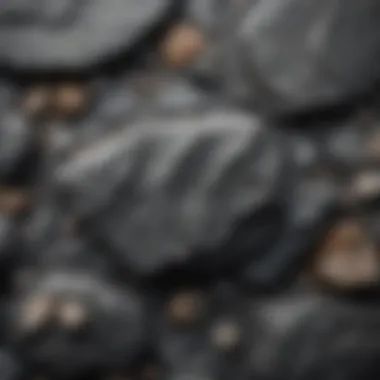
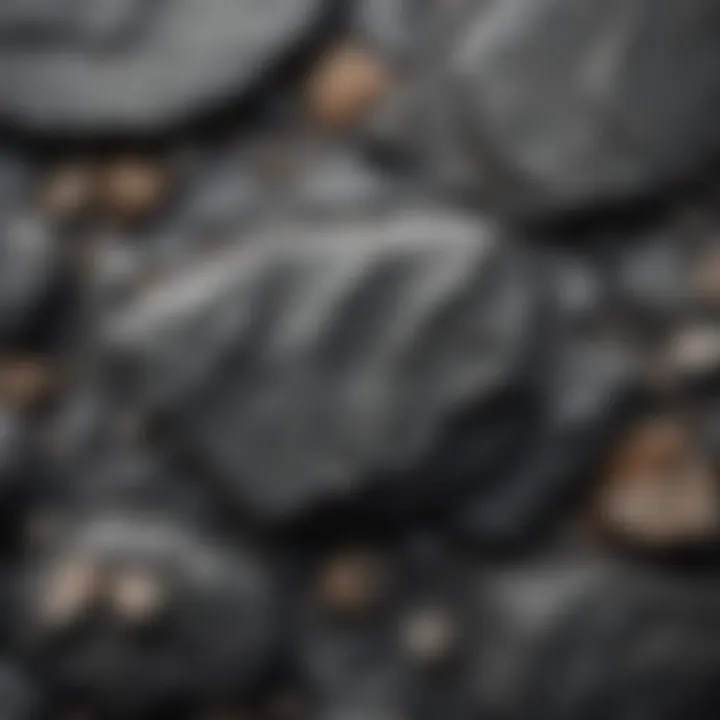
Intro
Basalt rock, often found in volcanic regions, has a special place in the realm of geology due to its abundance and unique characteristics. Formed from the rapid cooling of lava on the Earth's surface, basalt exhibits a variety of textures, colors, and mineral compositions depending on its specific formation environment. This article sets out to delve into the essence of basalt: its formation, properties, uses, and its cultural significance through the ages.
The relevance of basalt can’t be overstated; it forms the majority of the Earth's crust and is involved in numerous industrial applications ranging from construction materials to stone sculptures. Moreover, understanding basalt gives rock and fossil collectors a deeper appreciation of not only this rock itself but also how it shapes the landscapes we inhabit.
Collectively, we journey through this topic, seeking to unravel the multifaceted nature of basalt rock, discussing everything from its role in geology to its place in our history.
Featured Collectible of the Month
Overview
Basaltic rocks, often collected by enthusiasts, feature striking textures and a range of hues, from deep blacks to subtle greens. They can be shaped into beautiful items like coasters, countertops, or even sculptures. Collectors often appreciate the tactile quality and aesthetic appeal of polished basalt, which can serve as striking decor or educational pieces within a geological collection.
Historical Significance
Basalt has been utilized since ancient times. In some cultures, it was a favored material for tools and weapons due to its hardness. For instance, ancient Hawaiians would craft adzes and chisels from basalt, exploiting its durability and sharp edges. Not only did it serve practical purposes; its use in art and architecture also speaks volumes about human creativity and the rock's long-standing significance.
"Basalt's tactile quality and aesthetic appeal make it a prized collectible, reflecting both nature's artistry and human innovation."
Identification Techniques
Visual Characteristics
Identifying basalt doesn’t require a geology degree; often, one can recognize it by its dark color and fine-grained texture. Look for:
- Color: Basalt typically appears dark gray to black.
- Texture: It is usually fine-grained, and sometimes glassy, lacking visible crystals.
- Porosity: You may notice small holes or vesicles formed from gas bubbles trapped during solidification.
Resources for Identification
To enhance skills in identifying basalt, collectors may rely on various resources:
- Online forums: Websites like reddit.com host communities where collectors share tips and insights.
- Books: Guides on rocks and minerals can provide in-depth knowledge.
- Local geology clubs: Joining a club can connect enthusiasts to hands-on learning experiences.
In understanding basalt, collectors gain not only knowledge about the rock itself but the processes that have shaped its existence, allowing a deeper connection to the Earth's history.
Foreword to Basalt Rock
Basalt rock plays a critical role in our understanding of geological processes and the Earth's composition. Not only is it one of the most abundant types of igneous rock, but basalt also tells us a lot about the Earth's mantle and crust. This introduction provides the groundwork for exploring various aspects of basalt, helping readers grasp its significance as we delve deeper into its origins, properties, and applications.
Defining Basalt
Basalt is a dark, fine-grained rock primarily composed of pyroxene and feldspar minerals. Formed from the rapid cooling of lava that erupts onto the surface, basalt often exhibits a distinct black or gray color. The cooling process leads to a dense structure with a glassy texture, which sets it apart from other types of igneous rocks. This composition not only gives basalt its physical appearance but also makes it integral to various geological studies.
Key Characteristics of Basalt:
- Color: Typically black, gray, or dark green.
- Texture: Fine-grained due to rapid cooling.
- Composition: Rich in iron and magnesium, low in silica.
Understanding these defining features of basalt is important for collectors and enthusiasts, providing insights into rock identification and the processes that form different geological materials.
Significance in Geology
Basalt occupies a crucial place in geological research for several reasons. It significantly contributes to the composition of both oceanic and continental crust. In fact, oceanic crust is primarily made up of basalt, crafted from volcanic activity at mid-ocean ridges. The study of basalt reveals much about tectonic activities, volcanic eruptions, and the overall structure of our planet.
"The examination of basalt not only enhances our knowledge of the Earth's geological history but also aids in predicting future volcanic activities."
Moreover, sedimentary rock formation often involves weathering of basalt, which can lead to the creation of fertile soils, crucial for agriculture.
The Importance of Basalt in Geology:
- Foundation of Oceanic Crust: Predominantly composed of basaltic rock.
- Volcanism Studies: Helps in understanding eruptive mechanisms.
- Soil Fertility Contribution: Weathering forms rich soils for agriculture.
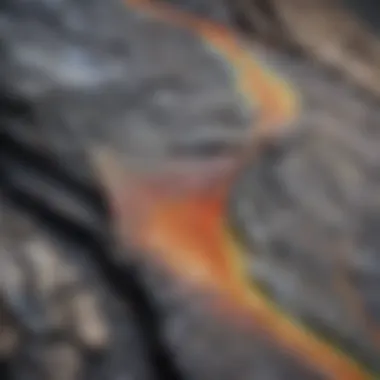
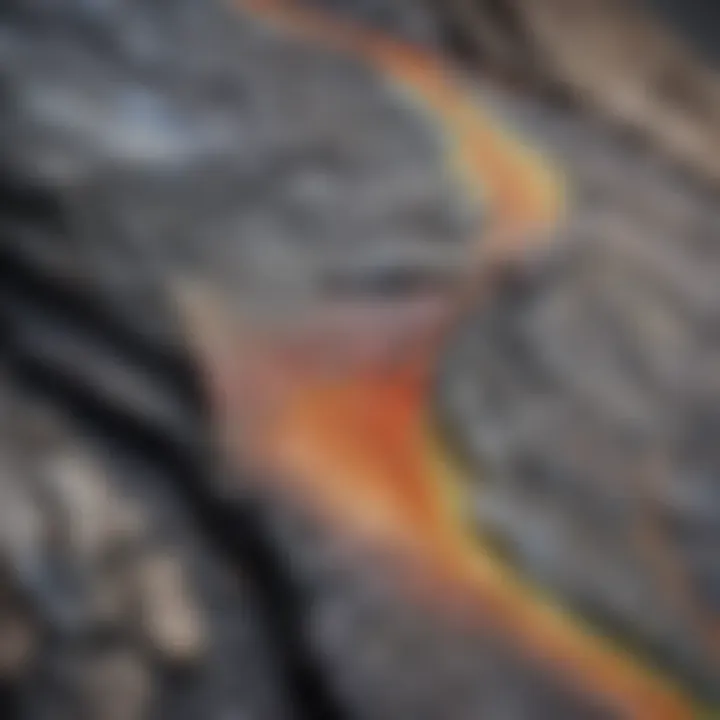
Overall, grasping the significance of basalt in geology illuminates its vital role in shaping both our Earth and its ecosystems.
Formation of Basalt
Understanding the formation of basalt is vital to grasping not just its material composition, but also its role in the larger geological processes that shape the Earth. Basalt forms primarily through processes associated with molten rock, and this sedimentary type can offer invaluable insights into the history of our planet. Such knowledge not only enriches our understanding of Earth's crust but also aids enthusiasts and collectors in identifying quality specimens.
Igneous Processes Involved
Basalt primarily forms from the cooling and solidification of lava that erupts from volcanoes or fissures on Earth's surface. The processes behind this igneous rock include both the genesis of magma from the mantle and subsequent eruptions. The origin can often be linked to decompression melting, where a reduction in pressure enables mantle rocks to melt, leading to the creation of magma. This liquid rock can then work its way through fissures or volcanic vents, eventually emerging as lava.
When the lava cools and crystallizes rapidly, it forms basalt, which is characterized by its fine-grained texture. Hence, the cooling rate is a crucial factor; faster cooling generally leads to smaller crystals and a smoother texture. For those collecting basalt, understanding these processes can aid in discerning the type and quality of the rock they are dealing with.
Types of Basaltic Eruptions
There are two main types of basaltic eruptions: effusive and explosive. Effusive eruptions are more common and occur when magma can flow freely to the surface, resulting in a relatively gentle release of lava. This type can create extensive lava flows, and the resulting basalt can spread over large areas. Prominent examples include the lava fields of Hawaii, where basalt flows have created dramatic landscapes over time.
In contrast, explosive basaltic eruptions happen when gas builds up in the magma, leading to violent expulsions of lava and gases. Such eruptions typically give rise to volcanic ash and pumice alongside basalt, altering the landscape significantly. Understanding these types can provide insight into the geographic distribution of basaltic formations and is crucial if collectors want to gather specimens that reflect the varied styles of basaltic eruptions.
Role of Plate Tectonics
Plate tectonics plays a pivotal role in the formation of basalt. Most basalt is found in regions where tectonic plates diverge, such as mid-ocean ridges. When these plates pull apart, magma rises to fill the gap, leading to basalt formation. It’s a continuous process, as new basalt is created even as old material is pushed away.
Moreover, subduction zones, where one tectonic plate slides beneath another, can also contribute to basalt formation through partial melting of the Earth's crust. The ensuing volcanic activity can produce unique basaltic compositions that differ from those formed at divergent boundaries. Collectors and geologists alike benefit from comprehending these tectonic processes, as they influence the varieties and distributions of basalt found throughout different regions.
Whether you’re a rock collector or just have a curious mind, knowing how basalt forms broadens your overall understanding of geological processes.
In summary, the formation of basalt is a complex process intertwined with the workings of Earth's mantle and tectonic activities. From the ways molten rock cools to different eruption styles and tectonic influences, each element contributes to the rich narrative of basalt's journey from the depths of the Earth to the surface rock that we so often collect and study.
Mineral Composition of Basalt
The mineral composition of basalt is a cornerstone in understanding its unique characteristics and behavior. This section delves into the vital elements that define this rock type, emphasizing how these minerals influence basalt's applications in various geological settings and industries. By analyzing these constituents, collectors and enthusiasts gain deeper insights into what makes basalt not just a geological specimen but a significant player in both nature and human endeavors.
Common Minerals Found
Basalt is rich in several minerals, with some being more prominent than others. The primary minerals often found in basalt include:
- Plagioclase Feldspar: This mineral dominates the composition, typically forming around 50-75% of basalt. It plays a critical role in defining the rock's texture and color.
- Pyroxene: Often present in notable amounts, this mineral contributes to basalt's hardness and its response to weathering. Its variations, like augite, are also prevalent in many basalt types.
- Olivine: While not as common, olivine adds a unique green hue to some basalt rocks. It's also an indicator of high-temperature conditions during the rock's formation.
- Magnetite: This mineral can impart magnetic properties to basalt, making it interesting for geological studies and even navigational uses.
Other minerals like iron oxide, amphibole, and small amounts of quartz can also be present, each contributing to the overall diversity and utility of basalt in different contexts.
"Basalt, with its rich mineralogy, is not just a rock; it's a tale of volcanic activity told through its composition."
Variations in Composition
Basalt isn't a one-size-fits-all type of rock; there's a genuine variability in its composition influenced by several factors. The crystal size, mineral diversity, and elemental ratios vary, leading to distinct basaltic forms:
- Tholeiitic Basalt: This kind primarily consists of iron and magnesium-rich composition, usually deeper in volcanic environments. It’s common in mid-ocean ridges and has a relatively low silica content.
- Alkaline Basalt: Rich in alkali metals, this variant is often found in rift zones and hot spots, displaying higher silica contents than tholeiitic counterparts. It allows for diverse mineral assemblages and unique textural features.
- Pillow Basalt: Recognized for its shape, this basalt form occurs during underwater eruptions. Its mineral composition reflects variations based on rapid cooling under water, often resulting in a distinctive glassy texture on the surface.
Collectors often note that understanding these variations isn't just about geology; it brings deeper appreciation for the conditions under which these rocks formed. Each composition tells a different story, allowing a richer interpretation of geological history.
In summary, the mineral composition of basalt is not merely a scientific detail, but rather a narrative that intertwines with the Earth’s processes and human usage. Enthusiasts and collectors are encouraged to look at basalt from this perspective, appreciating it not only as a rock but as a connection to the Earth's dynamic history.
Physical Properties of Basalt
The physical properties of basalt are essential to understand, as they offer insights into its formation, applications, and the roles it plays in different environments. Basalt's characteristics, such as texture, color, density, and hardness, not only aid in identifying the rock but also provide clues about its geological history. Moreover, these properties influence how basalt can be utilized in various industries, from construction to technology, making a thorough exploration of these elements crucial for enthusiasts and professionals alike.
Texture and Color Variations
Basalt typically displays a range of textures and colors that reveal much about its formation process. The common texture is fine-grained due to the rapid cooling of lava after an eruption.
- Aphanitic Texture: In most cases, one will note the aphanitic texture. This results from the rapid cooling of basalt in lava flows. It leaves the rock with small, barely visible crystals, which can be challenging to discern without assistance.
- Porphyritic Texture: In some basalt varieties, larger crystals are embedded within the finer matrix, leading to a porphyritic texture. This suggests slower cooling at some stages, allowing larger mineral crystals to form before the surrounding material solidified.


Regarding color, basalt can range from deep black to a lighter gray or even greenish shades, depending on its mineral content. The black coloration primarily comes from the abundance of iron and magnesium-rich minerals such as olivine and pyroxene. The presence of different minerals can lead to interesting color patterns, enhancing aesthetic appeal for collectors. The variegated colors add a fascinating dimension when discussing the rock's significance in various cultures and structures.
Density and Hardness
Basalt is renowned for its density and hardness, making it a durable choice for several applications. Its density typically ranges from 2.7 to 3.0 g/cm³, depending on composition. This impressive mass makes basalt's robust characteristics particularly advantageous in construction.
- Hardness: On the Mohs scale, basalt ranks approximately 6 to 7, which indicates good resistance to scratching and abrasion. This strength allows it to weather well, even in challenging environments, as seen in natural formations like columns or cliffs. Collectors highly prize these variations not only for their geological interest but also for their rough beauty in landscaping.
- Applications: The combination of density and hardness makes basalt suitable for various uses. In landscaping, crushed basalt serves as gravel or decorative stone. Additionally, it provides resilience in road construction and has even found application in the production of basalt fiber, which is valued for its strength and lightness.
In summary, understanding the texture, color, density, and hardness of basalt allows collectors and enthusiasts to appreciate this rock more fully. Exploring these attributes paves the way for a deeper discussion about its geological significance and the context in which it occurs, enriching the overall understanding of basalt in both natural and human spheres.
Basalt and Earth's Crust
Basalt, a common volcanic rock, plays a critical role in shaping both the continental and oceanic crusts of our planet. Its significance is not merely academic, for understanding basalt extends beyond geological science; it touches upon matters that influence construction, infrastructure, and even environmental health.
Role of Basalt in Continental and Oceanic Crust
When we examine the structure of Earth's crust, basalt emerges as a major player, especially beneath oceanic regions. The oceanic crust is primarily composed of basalt, which forms after magma from the mantle erupts and cools rapidly under water. This lavas forms what's called mid-ocean ridges, expansive underwater mountain ranges. Up to 70% of the total crust is basaltic, yet it's often overlooked.
On the continental side, basalt exists in a far different context. While granite might take the spotlight, basalt still claims a significant role. Flood basalt provinces, like those in the Columbia River Basin, are prime examples. These flows can create vast areas of flat land that are rich in mineral resources. These basalt layers can influence weather patterns, hydrology, and even ecology. The minerals in basalt contribute to fertile soils, aiding agriculture.
Moreover, basalt serves as a natural foundation for numerous infrastructures, reinforcing its importance in our everyday lives. From roads to buildings, engineers often rely on this sturdy material.
Tectonic Settings of Basalt Formation
Basalt formation is interwoven with the very mechanisms that shape our planet's surface. It typically arises in settings where tectonic plates diverge, converge, or transform.
- Divergent Boundaries: Here, tectonic plates move away from each other, allowing magma to rise and solidify as basalt. The atolls of Iceland, geologically young and bustling with volcanic activity, exemplify this setting.
- Convergent Boundaries: Basalt can also appear at subduction zones where an oceanic plate descends beneath a continental plate. This scenario causes intense pressure and heat, transforming basalt into varied forms.
- Hotspots: Not located near tectonic boundaries, these areas, such as the Hawaiian Islands, exhibit unique basalt features due to molten rock breaking through the crust.
The interaction of these tectonic settings doesn't just affect land formations; it influences ecological zones too. Thus, by understanding where and how basalt forms, one can glean insights into related geological phenomena, including earthquakes and volcanic distributions.
In essence, basalt is not just the building block of the Earth’s crust; it is a dynamic element that reflects the planet's geological story.
To summarize, basalt's crucial functions in both the continental and oceanic crust make it a central theme in understanding Earth's geological narrative. Its diverse origins and robust applications ensure that this volcanic rock remains at the forefront of geological research, attracting attention from enthusiasts and experts alike.
Basalt in Human History
The historical narrative of basalt is rich and varied. From the foundations of ancient structures to the intricacies of art, this rock has transcended its geological significance. Understanding the role of basalt in human history sheds light not only on its physical properties but also on how societies have harnessed its potential for countless applications.
Historical Uses of Basalt
Throughout history, basalt has marked its presence in various cultures as a versatile material. Ancient civilizations, notably the Egyptians, recognized its durability and aesthetic qualities. For instance, the famous statues and obelisks of ancient Egypt often utilized basalt, showcasing its capacity to withstand the test of time.
Another remarkable mention is the Roman use of basalt in road construction. The Romans had an exceptional mastery of engineering, and their roads made of basalt have lasted for centuries, a testament to its strength and resilience. This stone's role extended to the Medieval period, where it was used in fortifications. Many castles, constructed during this time, incorporated basalt for both structural integrity and decorative purposes.
Moreover, the prominence of basalt didn’t stop at architecture. In Japan, basalt stones became integral to the art of garden design, endlessly inspiring tranquility and simplicity. The traditional Zen gardens often feature these stones, emphasizing their significance not just as building material but as part of aesthetic philosophy. This blend of beauty and functionality illustrates how basalt has woven itself into the fabric of human culture through the ages.
Cultural Significance Across Regions
The cultural impact of basalt differs across various regions, reflecting local traditions and beliefs. In some Indigenous cultures, basalt rocks have spiritual significance. They are often seen as symbols of strength and endurance. Various Native American tribes use basalt for crafting tools, exemplifying their resourcefulness and deep connection to the land.
In contrast, the volcanic islands of Hawaii showcase basalt in their unique cultural practices. The Hawaiian people, renowned for their close relationship with nature, utilize basalt for crafting tools and ornamental items. The luminous black stone often signifies strength and permanence in Hawaiian mythology.
Similarly, in the Pacific Northwest, tribal groups created stone carvings and totem poles from basalt, linking their artistry to their heritage and the earth itself.
"Basalt is not merely a rock; it is a canvas reflecting the ethos, strength, and artistry of communities across generations."
The diverse uses and significance of basalt across cultures speak volumes about its impact on human ingenuity and creativity. From sturdy structures to artistic expressions, basalt has indeed shaped human history in profound ways but also reflects the ever-evolving relationship between humanity and nature.
Understanding basalt is essential for those who value geology and cultural history alike. It offers insight into how a seemingly simple rock can carry the weight of human achievement throughout time.
Industrial Applications of Basalt
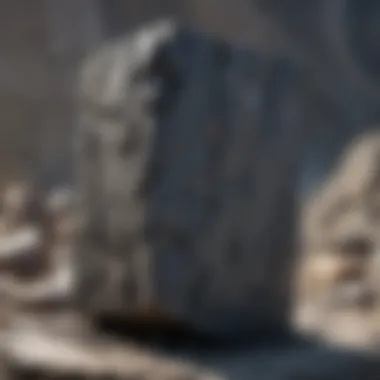

Basalt rock, with its rich array of characteristics, plays a pivotal role in various industrial sectors. Its durability, abundance, and thermal stability make it a material of choice in many applications. A deep dive into its uses reveals how basalt not only meets the functional demands of modern construction but also contributes to sustainability and innovative technologies.
Construction and Architectural Uses
In the realm of construction, basalt has carved out a niche that is hard to overlook. Its strength and resistance to weathering make it ideal for use in concrete, aggregates, tiles, and even flooring. Basalt's natural beauty adds aesthetic appeal, evident in polished stone surfaces and decorative features in buildings.
Notably, basalt blocks have been treasured for their practical applications. Structures built from basaltic stone tend to stand the test of time. This durability stems from its compact structure, which allows it to endure harsh conditions, from frost to drought. Examples abound in historical architecture, where basalt has been employed for centuries, such as in the walls of the ancient city of Machu Picchu, showcasing its enduring nature.
"In a world where sustainability is increasingly valued, the use of basalt in construction not only promotes durability but also minimizes environmental impact, given its natural abundance."
In urban planning, basalt is increasingly appearing in landscapes, thanks to its low maintenance and effective drainage properties. Undulating basalt-paved walkways enhance both functionality and aesthetic perspectives of urban spaces, making them popular among architects.
Basalt Fiber and Composites
The advent of basalt fiber technology has transformed traditional materials into advanced composites. Basalt fibers are made from finely drawn fibers from basalt rock, producing lighter yet stronger alternatives to glass and carbon fibers. These fibers exhibit impressive resistance to chemicals and elevated temperatures, making them ideal for various industrial applications including automotive components, aerospace structures, and electronic products.
One notable benefit of basalt fiber is its eco-friendliness. The production process requires less energy compared to glass fibers, yielding less waste. As industries seek greener solutions, basalt fiber is positioned as a favorite among sustainable materials. This can appeal to businesses aiming for eco-certifications.
In construction, basalt fiber reinforced composites might be used in reinforcing concrete structures to enhance durability, prevent cracking, and extend service life. The lightweight nature of these composites also contributes to lessening overall construction costs and improving handling efficiency.
Potential in Renewable Energy Technologies
When it comes to renewable energy technologies, basalt offers potential that may seem surprising to some. Its chemical properties can be harnessed in the creation of solar panels, lead to strong interest in geothermal energy projects, and contribute to the development of carbon capture technologies. Basalt has inherent thermal stability, making it a suitable candidate for energy storage applications, particularly in concentrating solar power plants where heat retention is essential.
Moreover, basalt’s ability to transform into basaltic glass during the melting phase enriches its utility in the production of high-strength cables and insulators for electrical systems. Its resilience against high temperatures and electrical conductivity pursuits innovation in technology manufacturing, suggesting a broader role in future energy solutions.
Collecting Basalt
Collecting basalt can often feel like a treasure hunt, revealing pieces of Earth's long geological history. For rock and fossil enthusiasts, gathering basalt specimens is not just about the aesthetic or collectible value; it's about understanding the processes that shaped these hardened lava flows. Much like searching for a needle in a haystack, finding quality specimens can be both challenging and rewarding. Every piece tells a story, from the environment it formed in to the conditions that influenced its texture and mineral makeup.
Identifying Quality Specimens
When it comes to identifying quality basalt specimens, knowing what to look for is crucial. Here are some key aspects to consider:
- Color and Texture: Basalt typically exhibits a dark color ranging from black to dark gray. A good specimen should display a fine-grained texture, with features such as vesicles (small gas bubbles) that signify rapid cooling. If the basalt has a shiny appearance, this is often due to the presence of iron-rich minerals washed over its surface.
- Physical Characteristics: Weight can be deceiving; quality basalt will feel heavier than it looks due to its density. The presence of olivine crystals can also enhance a specimen's appeal. In many cases, the contrast between the dark matrix and the lighter crystals can provide key visual interest.
- Lack of Weathering: Seek out pieces that haven’t been extensively weathered or altered. Weathering can diminish both the visual appeal and the geological significance of a specimen. A fresh-looking sample can provide better insights into the original volcanic processes that formed it.
- Location Context: The best specimens often come from specific geological locations. Collecting along basalt flows or structures associated with volcanic activity can yield interesting variations. Each collector should educate themselves on local geology to enhance their hunt, ensuring they're looking in the right spots.
Preservation Techniques for Basalt
After collecting quality basalt, preservation becomes the next focal point. Here are techniques to ensure your specimens remain in prime condition:
- Proper Cleaning: Avoid using harsh chemicals. Instead, gently clean your basalt with water and a soft brush to remove dirt and debris without damaging the surface.
- Storage Conditions: Store your specimens in a controlled environment. Avoid exposure to direct sunlight and humidity, as both can lead to deterioration. A stable, dry place such as a glass cabinet can do wonders to maintain the integrity of your collection.
- Display Techniques: If you choose to showcase your basalt pieces, opt for display cases that minimize dust buildup. Make sure to handle specimens with care, using gloves when necessary to prevent oils from your skin transferring to the surface.
- Documentation: Keeping records of where each specimen was collected, along with details about its geological context, can enhance its value in the long run. Include photographs and notes in a dedicated collection binder for easy reference.
"Collecting basalt is more than just a hobby; it’s like piecing together a puzzle of Earth’s volcanic history, one rock at a time."
In summary, collecting basalt offers a unique opportunity to connect with the Earth's deep history. By honing your skills in identifying quality specimens and employing effective preservation techniques, you not only build a remarkable collection but also contribute to the appreciation of geology and the stories these rocks carry.
Closure
In wrapping up our exploration of basalt rock, it becomes crystal clear that the subject is not merely an academic curiosity but a cornerstone of many geological and industrial narratives. This section provides a moment to reflect on the various facets of basalt, from its formation to its multifaceted applications, all while underscoring its significance.
Summarizing Key Insights
Throughout this article, we’ve journeyed through the intricate processes that give rise to basalt, examining its mineral composition and physical properties. Basalt forms largely from magma that cools quickly at the Earth's surface, resulting in a fine-grained texture that often presents in various colors—think of the beautiful dark tunics of the volcanic landscapes. In terms of geological importance, basalt is not only prominent in the oceanic crust but also in continental formations—yet another reason to appreciate its expansive reach.
Moreover, the article highlighted historical uses of basalt, emphasizing how civilizations have long drawn upon this natural resource for building materials and tools, paving roads with it, and even in art and sculpture. From ancient structures to modern architecture, basalt represents longevity and utility. Communities around the world have woven this rock into their cultural narratives; thus, giving it a deeper significance that transcends mere geology.
Implications for Future Research
As we look to the future, the road is paved with exciting possibilities for research on basalt. Given its pivotal role in both natural and industrial contexts, studies exploring sustainable uses of basalt in construction, materials science, and environmental remediation are particularly timely. The emerging field of basalt fiber composites, for example, shows promise due to its lightweight yet strong characteristics.
Moreover, the interaction of basaltic rock with climate change is an area ripe for investigation. As scientists delve into carbon capture techniques, basalt may offer solutions worth exploring, whereby carbon dioxide is sequestered in reaction with the minerals. With the continued advancement of technology, particularly in geochemistry and material engineering, the full potential of basalt could be unlocked.
In closing, understanding basalt rock goes beyond mere exploration of a commonplace geological material; it encapsulates a vital story of the Earth’s history, its ongoing evolution, and its interactions with human innovation. The journey doesn’t finish here; it merely beckons for further inquiry and discovery.
"Basalt is not just a piece of rock, but a part of a larger narrative that connects us with the Earth's history and future possibilities."
- Join communities of enthusiasts or researchers on platforms like reddit.com or explore deeper geological insights through sites like britannica.com.
Whether you're a seasoned collector or a casual enthusiast, the ever-evolving understanding of basalt promises a captivating exploration ahead.



